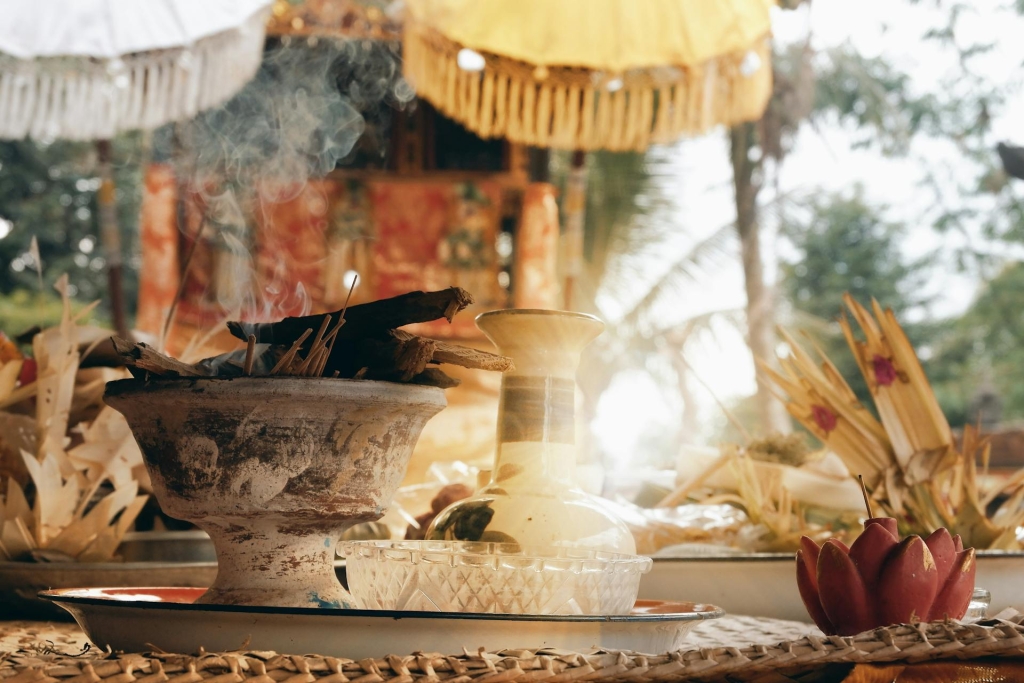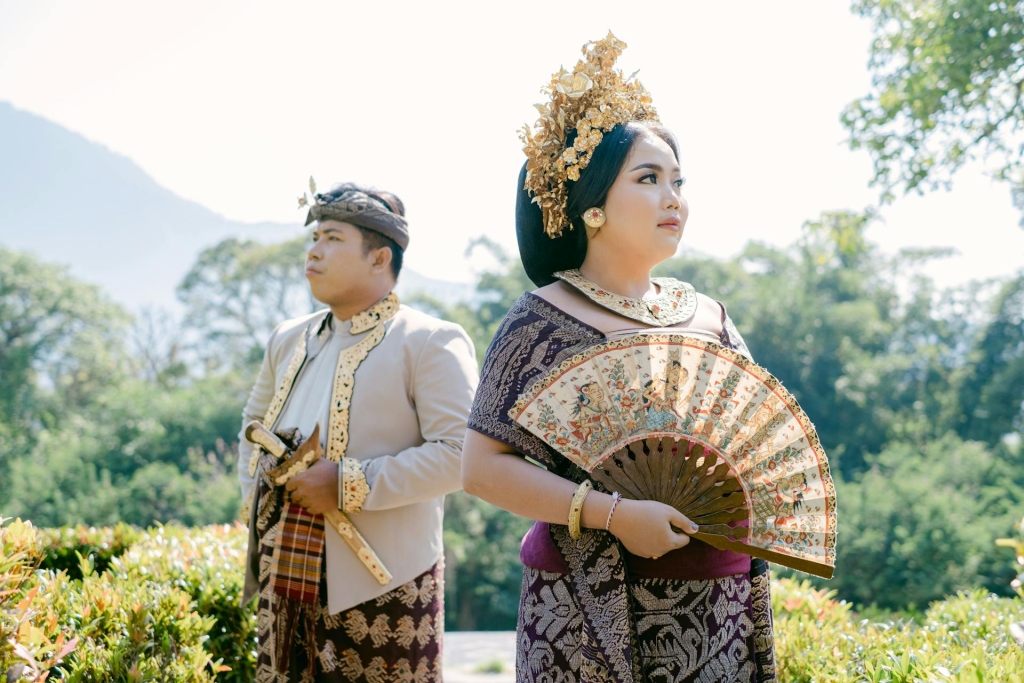Tradition in Bali
- International Property Alerts
- August 5, 2025
The tradition in Bali shapes how people live every day. From the way they pray to the way they cook, Balinese culture is full of meaning. Their lives follow a rhythm of offerings, temple visits, and festivals. Also, these customs are not just for show—they are part of daily life. Religion, art, and family all come together in this island’s way of living.
Bali’s spiritual roots come from a special kind of Hinduism. This belief system guides how people behave, how they treat others, and how they honor nature. So, at International Property Alerts, we believe understanding the tradition in Bali helps people feel more connected when visiting or living here.
Daily Rituals and Ceremonies in Balinese Life

The tradition in Bali shows in small things done each day. Therefore, these habits come from faith, family, and respect for nature.
Daily Offerings to the Gods
Each morning, families place small offerings called canang sari. To clarify, these are tiny baskets made from palm leaves. Inside, they put flowers, rice, and incense. People place them at doorways, temples, and even on cars. This simple act thanks the gods and keeps balance between good and bad. It also reminds people to stay kind and humble.
Temple Visits and Prayers
Bali has thousands of temples. Each village has at least three. Families visit temples to pray and give thanks. They dress in special clothes and bring food or flowers. The temples are quiet, peaceful places. Some visits happen daily. Others take place during full moons, holy days, or big events. That is to say, these moments bring families and neighbors together.
Family and Ceremony at Home
The tradition in Bali starts at home. Parents teach kids how to make offerings and show respect. When someone is born, marries, or dies, families hold special ceremonies. These are full of music, food, and prayer. They can last hours—or even days. Each one honors the gods and brings good energy to the family.
These customs are not only for show. They help guide daily life. Through them, people show care, love, and belief. So, the tradition in Bali is simple but full of meaning—something you’ll quickly notice when reading any honest country guide in Bali.
Balinese Festivals and Holy Days
The tradition in Bali shines during festivals and holy days. These special times mix faith, family, food, and fun in colorful and joyful ways, and those considering a longer stay can explore opportunities on international real estate websites.
Famous Festivals in Bali
Festivals in Bali are big events. They bring people together to celebrate life and thank the gods.
- Galungan – This festival celebrates the victory of good over evil. Families decorate their homes with tall bamboo poles called penjor. Also, people wear traditional clothes and visit temples.
- Kuningan – Held ten days after Galungan, Kuningan marks the return of spirits to heaven. Families prepare yellow rice and pray for blessings.
- Nyepi – Known as the Day of Silence, Nyepi is Bali’s New Year. No lights, cars, or noise are allowed. So, everyone stays home to rest and reflect.
- Saraswati Day – This day honors the goddess of wisdom. Students and teachers place offerings on books and pray for knowledge.
Important Holy Days
Holy days are quiet, meaningful times. So, people show their faith through simple acts.
- Full Moon (Purnama) – Every full moon is a holy day in Bali. Families pray and give offerings. The moon is seen as sacred and powerful.
- Pagerwesi – This day is for strengthening your spirit. Therefore, people pray for protection and guidance.
- Tumpek Days – These are small holy days that honor things like animals, tools, and music. Therefore, each one reminds people to care for what they use every day.
Every celebration tells a story. The tradition in Bali lives through music, food, and prayer. These days bring people closer and keep culture alive.
Traditional Balinese Architecture and Design
The tradition in Bali is not just in people’s actions. You can also see it in the way homes and temples are built across the island.
Homes That Follow Beliefs
Balinese homes follow rules based on faith. That is to say, each house is made up of small buildings inside one yard. There’s a special place for cooking, sleeping, and praying. Families build shrines inside the yard to honor their gods. Also, they believe that the home should stay in balance with nature and the spirit world.
Temples That Tell Stories
Temples in Bali are holy and full of meaning. Carvings show stories from Hindu tales. Statues of gods and animals protect the area. The layout always follows the flow of energy. So, builders place holy spaces higher up and cleaner areas away from roads. The tradition in Bali shapes how these temples look and feel.
Natural Materials with Meaning
Builders use things from nature like wood, stone, and bamboo. Roofs are often made from palm leaves or clay tiles. These materials keep the house cool and show respect for the earth. Also, each part of the home has a meaning. Even the gate has symbols for safety and luck.
Foreigners Respect Local Designs
People who buy real estate in Bali often admire these designs. Some add Balinese touches to their villas. In addition, others keep the style to respect local ways. This shows how the tradition in Bali can mix with new ideas without losing its soul.
Balinese design is more than style. It is faith turned into buildings. Each home or temple tells a story and connects the people to their culture. When exploring our properties, it helps to understand these traditions, as they often influence the surrounding environment and the way local communities build and live.
Music, Dance, and Artistic Expression
The tradition in Bali comes to life through music, dance, and art. These are not just hobbies—they are part of how people pray, tell stories, and celebrate.
The Sound of Gamelan
Gamelan is traditional Balinese music. It uses gongs, drums, and metal keys. The sound is rich, loud, and full of energy. Gamelan plays at ceremonies, temple events, and dances. Kids learn it from a young age. Also, each beat and rhythm follows special rules passed down for generations.
Kecak Dance and the Power of Voice
The Kecak dance is one of Bali’s most famous shows. It uses no music. Instead, men sit in a circle and chant “cak-cak-cak” while dancers act out old stories. The dance tells parts of the Ramayana, a Hindu epic. The fire, costumes, and voices make it exciting to watch. That is to say, it shows how the tradition in Bali mixes sound, story, and spirit.
Wayang Kulit and Shadow Stories
Wayang Kulit is shadow puppet art. Therefore, a storyteller holds flat puppets behind a white screen. A light behind them creates shadows that move with each scene. These shows share lessons about good and bad, bravery, and kindness. It’s a fun way to teach and entertain at the same time.
Art That Speaks to the Soul
Painting, carving, and mask-making also play big roles. Artists often make work for temples or ceremonies. Some paintings tell old stories, while others show gods or daily life. Every piece has a deeper meaning. That’s why the tradition in Bali stays alive—not just in temples, but in every brushstroke and dance step.
Living Culture Through Art
Art in Bali is not just for looks. It teaches, honors, and connects people. It’s how culture speaks without words.
These creative forms are more than just art—they are living parts of the tradition in Bali. Through music, dance, and stories, each generation learns and remembers what matters most.
Traditional Balinese Clothing and Attire

Clothing is a big part of the tradition in Bali. What people wear shows respect, belief, and beauty, especially during temple visits and ceremonies.
Sarongs
Sarongs are worn by both men and women. It’s a long cloth wrapped around the waist. People wear it when visiting temples or during ceremonies. In other words, it covers the legs and shows respect.
Temple Sashes
A temple sash, or selendang, is tied around the waist. It helps keep energy in balance during prayer. The sash also shows that the person is ready for worship.
Kebaya
Women often wear a kebaya. It’s a lace blouse with long sleeves. The kebaya is soft and usually worn with a colorful sarong. So, it adds grace and beauty to formal events.
Udeng
Men wear a head cloth called udeng. It is folded in a special way and tied neatly. The udeng also shows that the man is focused and ready to pray.
Kain Songket
Kain songket is a fancy fabric used on special days. It shines with gold or silver threads. Therefore, people wear it during weddings and big festivals.
Batik
Batik is a hand-dyed fabric with detailed patterns. People wear batik shirts, dresses, or wraps for casual or formal times. The designs often tell a story or carry a message.
Traditional clothing in Bali is more than fabric and color. It reflects faith, family, and identity. So, wearing it with care shows love for the tradition in Bali and respect for others.
Balinese Food Culture and Traditional Practices
Food is a big part of the tradition in Bali. So, it’s not just for eating—it’s a way to show love, respect, and connection to others.
Food as Daily Offering
In Bali, people prepare food as gifts to the gods. In other words, these offerings are called banten. They may include rice, fruit, flowers, and sweets. Families place them at temples and shrines every day. Also, these small acts keep balance between humans and spirits.
Eating Together
Balinese families often eat together on the floor. Therefore, everyone shares the same dishes. Meals are quiet, and people show respect by waiting for elders to begin. In addition, during special events, neighbors cook together. This shows teamwork and care.
Traditional Dishes
Balinese food is full of flavor. That is to say, it uses spices, herbs, and coconut. Some famous dishes include:
- Babi Guling – Spit-roasted pork with rich spices
- Lawar – A mix of vegetables, coconut, and minced meat
- Bebek Betutu – Slow-cooked duck wrapped in banana leaves
- Sate Lilit – Minced fish or chicken grilled on sticks
- Nasi Campur – Rice served with different meats and veggies
These foods are served at family events, temple days, and village feasts. Also, recipes are passed down through generations.
More Than Just a Meal
The tradition in Bali treats food as something sacred. It feeds the body, honors the gods, and brings people closer. Food is prepared with care and shared with joy.
Balinese food culture is rich, warm, and full of meaning. It shows how even a simple meal can carry deep respect and strong family ties.
Community Life and Social Harmony
The tradition in Bali teaches people to live with respect and care. So, every village follows customs that build strong, friendly, and helpful communities.
Banjar
A banjar is a group of families living in one area. Each banjar holds regular meetings, plans events, and gives support during big life moments. Also, people in the banjar take turns helping with weddings, funerals, and temple days. Every member plays a role and knows their duty. No one gets left behind.
Gotong Royong
Gotong royong means working together for the good of all. Villagers clean streets, fix roads, or prepare for festivals. To clarify, they don’t ask for payment—they give time and effort freely. These group tasks bring people closer and teach kids the value of teamwork. Everyone helps, no matter their age or job.
Culture Shapes Every Action
The tradition in Bali encourages people to respect others and stay connected. Neighbors greet each other with a smile. Families share food during ceremonies. Parents teach kids to say thank you and offer help. So, these small habits create trust and peace across villages.
Balinese people build strong communities through action, not just words. They live by rules that bring balance, kindness, and teamwork. The tradition in Bali makes community life feel like one big family.
The Role of Religion in Balinese Traditions
Religion shapes daily life and guides every action in Bali. That is to say, the tradition in Bali grows from deep beliefs, regular prayers, and strong ties to the gods.
Balinese Hinduism
Most Balinese people follow a unique form of Hinduism. It mixes Hindu teachings with local customs. To clarify, this faith teaches about gods, nature, and balance. People believe that good and bad must stay in harmony. They use prayers and rituals to keep this balance strong.
Daily Practices and Beliefs
Every home in Bali has a small shrine. Families pray there each day. For instance, they offer flowers, rice, and incense to thank the gods. These small offerings show love and respect. People also visit temples often. Some go daily, while others go on full moons or holidays.
Big Ceremonies and Life Events
Religion plays a big role during birth, marriage, and death. Each life stage has its own ceremony. Families invite neighbors to join. These events include prayers, food, music, and dancing. Also, they help connect people to each other and to the gods.
Religion isn’t just something people follow in Bali—it’s a way of life. The tradition in Bali teaches people to live with kindness, balance, and deep respect. Faith lives in every prayer, every offering, and every celebration.
Why Understanding Balinese Traditions Matters for Foreign Residents
The tradition in Bali is not just for locals. Foreign residents can learn a lot by understanding how Balinese people live, pray, and connect with each other.
- Show Respect: Learning the customs shows that you care about the local way of life.
- Build Trust: Neighbors feel more comfortable when you follow their rules and join their practices.
- Avoid Mistakes: Some actions may seem normal to you but may offend locals. Knowing the rules helps you avoid this.
- Join Community Life: You can take part in village events, temple days, and ceremonies when you know what to do.
- Keep the Peace: Following the tradition in Bali helps everyone live together in harmony.
- Support Local Culture: When you respect traditions, you help keep them alive for future generations.
- Improve Your Stay: Life in Bali feels smoother when you understand and follow local ways.
- Learn Something New: You gain new views, habits, and wisdom that you may carry forever.
Respect goes a long way in Bali. The tradition in Bali teaches kindness, patience, and care for others. When you follow it, people see you as part of the community—not just a visitor. Learning these customs isn’t hard, but it means a lot. That’s why understanding local culture is a key part of choosing a home through our services.
Key Takeaway
The tradition in Bali touches every part of life. From daily prayers to village teamwork, it shapes how people live, eat, and celebrate. Learning these customs helps you connect and feel welcome.
At International Property Alerts, we believe culture matters as much as location. If you want to live or invest in Bali, knowing the local ways is a smart first step. Respect builds trust. Kindness creates peace. If you want to learn more about living in Bali, contact us today.
FAQs
Why is the tradition in Bali important in daily life?
The tradition in Bali shapes how people act, pray, and celebrate. So, it’s part of their food, clothing, and even their homes. These customs keep families and communities strong and connected.
What are some daily customs Balinese people follow?
Balinese families make small offerings called canang sari every morning. Also, they visit temples to pray and dress in special clothes for ceremonies. These daily habits show faith and respect for nature and the gods.
How do festivals show the tradition in Bali?
Festivals like Galungan, Nyepi, and Saraswati blend prayer, food, and family time. They honor gods, tell stories, and bring people together. In other words, every event has deep meaning and keeps culture alive.
How should foreigners respect Balinese customs?
Learn the basics—like what to wear and how to greet. Join village events if invited and follow temple rules. So, respecting the tradition in Bali builds trust and shows you care.
How does Balinese art connect to tradition?
Music, dance, and shadow puppets teach values and share stories. Gamelan and Kecak dances are not just for fun—they honor history and faith. Art keeps the tradition in Bali alive through every sound and movement.
About International Property Alerts
International Property Alerts is a premier global platform connecting real estate investors with handpicked opportunities in emerging and lifestyle-driven markets. Through curated listings, expert guidance, and market insights, we help buyers make confident property decisions worldwide.
Media Contact:

Phone: +4477 1923 8132
📱 WhatsApp: +63927 073 9530
Email: office@internationalpropertyalerts.com
Services
Related Post
- Best Places To Retire
- Hidden Places Destination
- Best Regions To Retire
- Guide To Global Life
- Affordable Places To Retire
- Elly's Insights
- Business Outlook
Discover Prime Global Opportunities

Elle Resort & Beach Club – Your Prime Beachfront Investment
Elle Resort & Beach Club offers a rare chance to own property in one of the most desirable coastal locations. With limited units, strong capital growth potential, and unmatched resort facilities, this is your opportunity to secure a beachfront lifestyle with long-term value.

Smarter Property Investments Start Here
Thinking about buying property abroad? Don’t make the move without the right knowledge. Our Free Buyers Guide gives you essential insights on legal steps, taxes, financing, and the best markets worldwide. Trusted by international buyers and investors.

Your Perfect Home Awaits at Sudara Residences
Wake up to bright, spacious living with stunning views and modern comforts. Whether for family living, retirement, or a stylish retreat, Sudara Residences makes your dream home a reality

Own a Piece of Cambodia’s Thriving Property Market
Discover curated property listings with IPS—residential, commercial, villas, land—and get expert guidance through every step.
BONUS: FREE Cambodia Buyer’s Guide

Grow Your Business - Advertise in a Prime Spot
High visibility. Targeted audience. Maximum exposure. Rent this space and let your brand shine.

Got Properties to Sell?
Get your properties in front of high-intent investors. Showcase your listings to buyers worldwide.

Exchange Without Borders
From pounds to pesos, yen to dollars. ⚡ Quick. Easy. Secure.
